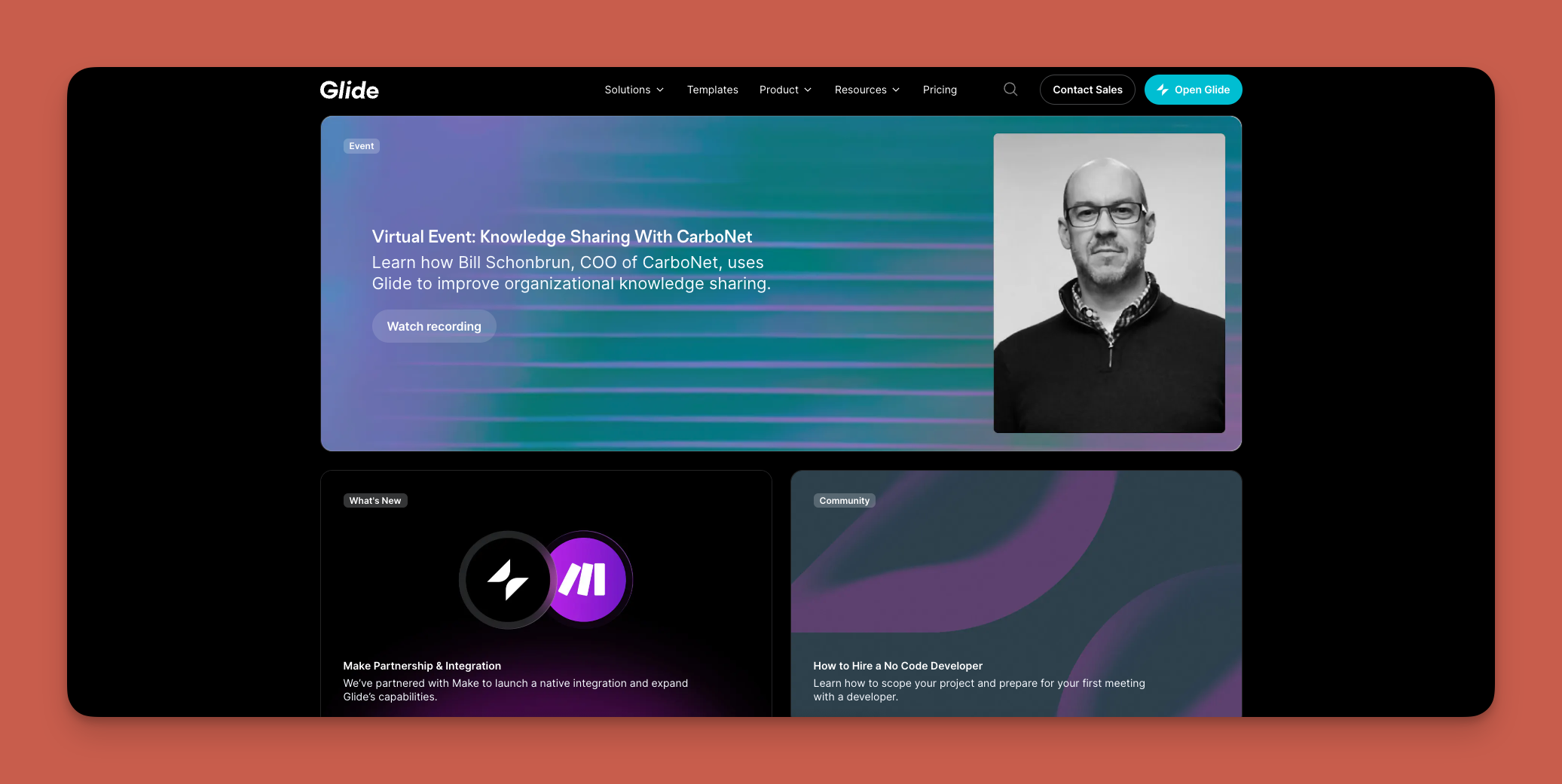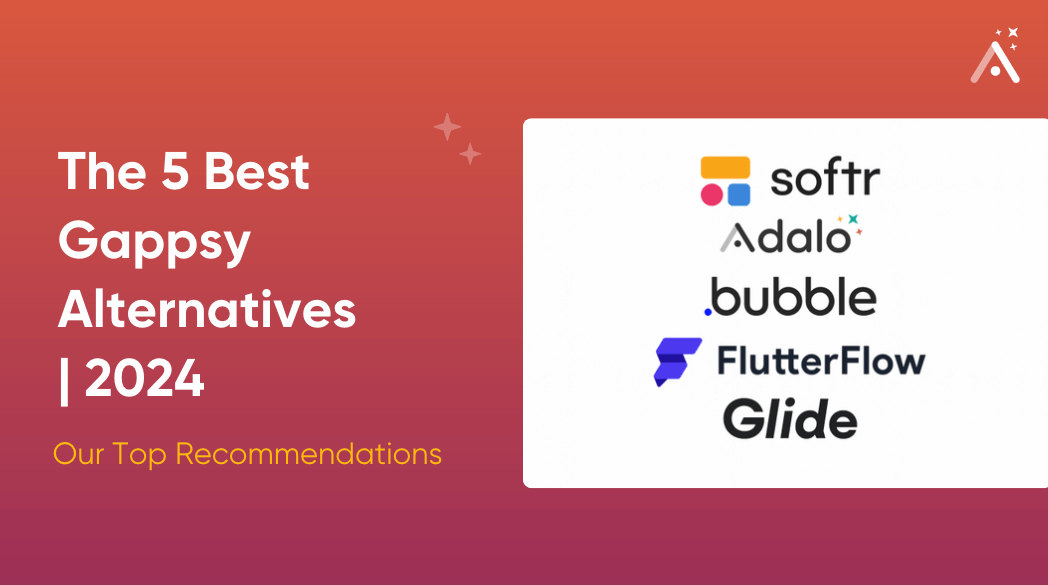The Bottom Line: Glide is a serious app builder best suited for building apps used by medium to large-sized organizations. While it’s packed with power and aesthetics, certain segments will be better served using other app-building platforms.
Pros:
- Glide has a building interface that allows you to create professional-looking and aesthetically pleasing apps with little effort.
- You’ll have tons of templates to choose from.
- It comes packed with super useful components and integrations, including one of the best AI tools currently available.
Cons:
- Glide is priced on the higher end of most no-code app builders.
- You’ll need to start with a database, making Glide more geared toward businesses than freelancers and entrepreneurs. Starting with a database limits how much you can customize your app.
- If you want to create a native mobile app you can publish on the app stores, you’ll need to use a third-party application, which can affect your app’s quality.
Pricing: Glide offers a free version that gives you access to its vast template library and introduces you to its building interface. However, to use Glide’s unique AI tools and other features, like custom web publishing, you’ll need to upgrade to the Maker Version, which costs $60/month.

What is Glide?
Glide is a powerful no-code app-building platform that lets you create exquisitely sleek web apps and progressive web apps (PWAs). Your users can access web apps with the browsers on their mobile devices.
PWAs are apps that users can download directly to their mobile devices from a link or QR Code. They function just like native mobile apps, but here’s the difference: They can’t be published in the Apple App Store or Google Play Store, meaning they miss out on reaching a billion-plus audience.

Glide Review: Getting Started
After signing up for Glide’s free version, you’ll land on a dashboard. The first thing you’ll see at the center of your screen is a beginner’s tutorial, followed by 4 intro videos at the bottom. Before jumping right into the beginner's tutorial, we recommend you check out the intro videos first.
Each video tutorial ranges from 2.5 to 6.5 minutes. They’ll give you a quick rundown of everything you need to know to use Glide like a pro: How to organize your database, how the app-building interface works, how to publish, and everything else.
After you finish watching the videos, jump into the tutorial to familiarize yourself with Glide. Then, it’s time for the fun stuff: Building your app! Glide gives you the option to start building your app from scratch or choose from its expansive library of over 100 premade templates.
You’ll find templates grouped into the following categories:
- AI
- Operations and Field
- HR and Hiring
- Sales and CRM
- Portals and Dashboards
- Project Management
- Event Management
- Education and Nonprofit
- Personal
When browsing each template by category, you can preview each one. This is convenient because it gives you a feel of what sort of app you can create. Some templates are free, and others come at a cost, which ranges from under $100 to $499+.
Once you choose the template you want, you’ll go straight into building your app. When you open the Glide app-building interface, you’ll notice its aesthetics right from the get-go: Glide provides one of the easiest-to-look-at app-building experiences.
You’ll also be prompted to select a data source. For those who have a database, this simplifies building your app. But if you don’t have one, fear not: You can edit the pre-loaded database that comes with the template you selected to meet your needs.
Keep in mind that you’ll need to create a database before you make your app screens. So, approach creating your app by building your database first. After all, Glide brands itself as a “data-first” app-building platform.
Editing your app using Glide is a breeze. The app-building interface’s main steering wheel consists of three tabs located at the top of your screen: Data, Layout, and Actions. Select the one you want to work on, and you’ll be able to toggle through different sections of your app using the drop-down dashboard that appears on your left-hand side.

When you click the “Layout” button, you’ll see your app’s canvas at the center of your screen. You’ll be able to click through it as if it were live. Configure your app’s layout in the drop-down dashboard on your right-hand side. Edit your app’s contents (like pictures, descriptions, and text) by selecting the “Data” button.
It’s also simple to add actions like integrations and other Glide tools into your app. All you need to do is press the “Actions” button to access Glide’s lengthy menu. Pick the action you want, and then you’ll be able to customize its logic.
Is Glide Right For You?
Glide is a great, easy-to-use app builder, but it has a limited audience. Select Glide if:
- You have a database that you want to make into an app.
- You want a slick, attention-grabbing app.
- You want to build an internal tool for your medium or large business.
However, you should take a look at other app builders if:
- You want to create an app that you can fully customize.
- You want to publish your app to the Apple App Store or Google Play Store.
- You don’t want to build your app from a database.
What Kinds of Apps Can I Build With Glide?
Glide is a solid choice for medium- to large-sized organizations and beyond, providing serious oomph for building business-enhancing solutions. Its primary superpower is building internal business apps like inventory trackers, project management boards, and CRM tools.
This is because Glide is designed to supercharge pre existing databases by leveraging integrations with data sources like Google Sheets, Airtable, and SQL and cutting-edge tools like Glide AI to execute tasks like data processing, picture recognition, and data organization.
You’re limited to creating internal business apps only. Glide provides templates for public-facing apps like e-commerce apps, restaurant apps, and more. If you’re ambitious, you can even cobble together your own client-facing app from scratch.
But Glide does limit the number of signed-in users you can have, so if you want to make a delivery app for your restaurant, you’ll need to ensure that all your clients use anonymous accounts.
Glide Pricing: Is it Worth it?
Get started with Glide’s generous free version, which allows you to publish one web app. Not only will you be able to learn Glide’s building interface, but you’ll also get a taste of integrating with third-party applications: Glide graciously allows up to three integrations.
Glide’s Maker Plan, at $60/month (billed monthly), is for individuals, freelancers, and entrepreneurs. While it only lets you create one app with 5GB of storage capacity, it offers Glide’s AI features, unlimited sign-ins, and dozens of third-party integrations.
If you need to create multiple apps, Glide’s Team Pricing tier has you covered. Glide allows you to make unlimited apps with 5 editors for $125/month (billed monthly). While you only get 20 sign-ins ($4/additional user), you get 100GB of file storage and the Glide API, which lets you update your data in real-time.
Large businesses and agencies should look into the Business Version, which costs $310/month (billed monthly). It offers up to 40 signed-in users ($6/additional user), 10,000 yearly updates, integrations with several data sources, and a call API to gather data from anyone who gives you permission.
If you’re a huge organization that needs more of a customized plan, try the Enterprise Version, which starts at $1,200/month (billed monthly). You can get more detailed info by contacting Glide directly.
Glide Alternatives: What Other Tools Should You Try?
Glide is an excellent app builder, but it’s not for everyone. Take a look at our alternatives:
- Adalo, if you want a competitively priced app-building platform for creating a completely customizable app that lets you make your database as you craft your app, which you can publish to the Apple App Store and Google Play Store.
- Softr, if you want a flexible app builder that lets you quickly create an app from a pre-existing database.
- Bubble, if you want a powerful app-building platform to build nearly any kind of web app you can imagine, and you’re up for the challenge of learning its building interface.
Verdict
And now, it’s time to hear our final opinion on Glide! Should you get it now, shortlist it, or avoid it?
Get it now if you’re a business with at least a few dozen employees and have a database that you want to transform into a stunning app.
Shortlist it if you’re a freelancer or entrepreneur with an app idea but don’t yet have a database.
If you want to build a native mobile app that you can publish to the Apple App Store or Google Play Store, look no further than Adalo. When you build with Adalo, you’ll work with a super simple drag-and-drop interface that you can use right out of the box.
Adalo also integrates with popular third-party apps like QuickBooks, Google Sheets, Zapier, and many more. Plug these in to give your app more juice.
If you have a database, you can plug it right into Adalo’s app-building interface. But if you don’t, you can build your database as you go. When you use Adalo, you get the perfect balance of simplicity and power so you can bring any app idea to life.
.png)

















